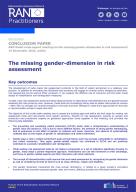Details
- Publication date
- 22 January 2024
- Author
- Directorate-General for Migration and Home Affairs
- RAN Publications Topic
- Formers
Description
The development of tailor-made risk assessment protocols in the field of violent extremism is a relatively new practice. In addition to evaluating the likelihood that someone will engage in criminal and/or dangerous behaviour, risk assessment serves several other purposes: it can support the efficient use of resources and the tailor-made design of rehabilitation and reintegration measures.
To date, most risk assessment tools have been based primarily on data about male offenders and are geared towards assessing the risks posed by men. However, these tools are increasingly being used to assess risks posed by women – often with no changes (or minimal changes) to the tools and their settings to make them appropriate for this task or accommodate women’s needs and risks.
The objective of this small-scale meeting was to assess the existing gaps and define the first steps for making risk assessment tools and instruments more gender sensitive. Experts on risk assessment, experts on gender and extremism and practitioner experts on gendered approaches came together in this meeting, and provided the following key outcomes.
- The preventing and countering violent extremism (P/CVE) sector lacks a comprehensive understanding of gender roles and dynamics. This is due to many different factors: the presence of strong gender stereotyping, lack of awareness on the effect of gender on relations and power dynamics, and absence of systematically collected data on the impact of gender on radicalisation and violent extremism.
- Gender plays a role in violent extremism’s push and pull factors and may increase vulnerability to radicalisation and violent extremism. Then again, gender-related aspects can contribute to P/CVE and can positively contribute to successful rehabilitation and reintegration.
- While existing risk assessment tools do not feature components or a set of indicators specifically focusing on gender, many adopt a person-responsive approach. Practitioners can use this framework to their advantage, and focus on gender-related aspects and their interaction with other elements.
- The concept of intersectionality could improve risks and needs assessment by recognising the gender dimension as well as considering its links to factors such as class, ethnicity, religion and disability.
- The gender dimension transcends the man–woman dichotomy; it relates to a given society’s normative framework that promotes expected gender roles and norms, affecting societal and individual behaviour.

